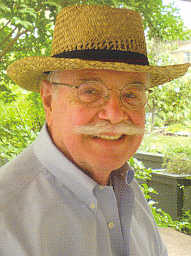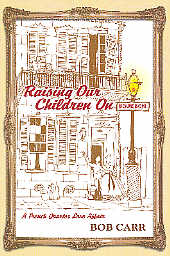Bob slipped and fell and one of the gals said, "I'll bet you're Timmy and Tammy's daddy, aren't you? They sure are cute
kids. I hope you don't mind us talkin' to 'em." With that the Carrs soon got to meet the exotic dancers who worked at the Sho-Bar strip joint down the street. The Carrs had friends who lived way out in River Ridge who were always touting how great it
was, and once Jan countered with, "Well, we may have a few strippers over the wall and in the Royal Street A&P, but at least
there aren't any pimps in the block!" (Page 75)
They were soon discovering the many wildflowers who lived and worked in the French Quarter, the oldest urban center
in the country, was full of wildflowers, some famous and some infamous. Al Hirt, Pete Fountain, and Chris Owens became good
friends and work associates, Clay Shaw allowed the Carr's kids to swim in his pool, Lee Harvey Oswald was spouting kudos
for Russia one day, and Truman Capote likely groped Bob in a Men's Room one night. Ruthie the Duck Girl, rolled by daily,
dressed in a ballet costume, carrying her duck, and always said, "Hi, Mr. Cahr!" when she whizzed past on her skates. To locals
the French Quarter became simply the Quarter and Jackson Square, the Square.
[page 88] Living in the Quarter could be likened to living in a field of varied wildflowers. Some are
beautiful while some are not; some bloom brightly and of long duration, while others pale and fade
quickly; but they all add to the uniqueness of the bouquet. The Square is the vase that, for a time,
brings the blooms together in an ever-changing arrangement.
Not being Catholic, the Carrs eventually gave in to the kids request to go to Mass in the large church on the Square, St.
Louis Cathedral. When it came time for communion, Tammy was ready to go.
[page 93] "When do we get in line, daddy?" Tammy asked quietly and confidently, her big brown eyes
peeking up from under her hat.
"We aren't getting in line, honey."
"Why?"
"Just because, dear."
"Because we aren't Catholic, silly," Timmy whispered loudly in Tammy's ear. "Pierre said ya
gotta be Catholic ta do that stuff, besides he said what ya get up there is a piece of bread that's
suppose to be God's skin and when ya eat, it sticks to the roof of your mouth!"
"Yuk!"
Suddenly Timmy pointed to a lady whose walking up the aisle to receive communion.
[page 93, 94] Moving out of the pew, she had slung her grandchild over her shoulder while
genuflecting — no easy balancing act on the slippery black and white marble floor. Unbeknownst to
grandma, the flailing child had somehow gotten a firm hold on the hem of her rather loose fitting,
rayon dress. The woman began to move reverently up the aisle, unaware that her grandbaby was
tugging on the fabric of her skirt. The child kept pulling until the whole backside of granny's garment
was in his tight little fist, exposing her rather scanty underpinnings, consisting merely of nylon hose
supported by a black satin garter belt. The more-than-ample flesh of her derriére quivered with each
innocent step toward the high altar. In a state of complete guilelessness, the unlikely Madonna strode
with babe in arms toward the Lord's supper.
Jan asked Bob to pull down that lady's gown, but he demurred. Soon members of the congregation were tittering as she
walked back. Bob was struggling to keep his composure, tears streaming down his eyes, as the following scene unfolded.
[page 94] Just as I glanced toward the front of the church, our lady was turning away from the priest.
His reaction at seeing her backside so disoriented him that he bumped the altar boy, almost causing
him to drop his paten. This was more than I could bear. I fell back onto the kneeler and wept openly.
Bob was rescued by the trumpet section in the choir loft which sounded like the Archangel Gabriel and restored him to
sobriety. But there would be one more encounter with the gown lady who had sat down and restored her gown to its proper
place. After the service was over, she approached Bob's pew with her two-year-old in tow.
[page 95] Passing our pew, she glance at me and smiled. She startled me as she leaned over and
whispered, "I've hear you and Miss Jan on my radio and I've seen and your beautiful family in the
neighborhood. Gawd Bless!"
I smiled back politely, but I was thinking, Lady, you have no idea where I've seen you!
Timmy at age 5 was asked to play a part in a play at Le Petit Theatre and so far as anyone could remember, he was the
youngest person to ever have a speaking part in the long history of the theater. For his part in Life with Father he needed his
hair dyed red and eye makeup. Not able to read yet, he also needed help with learning his lines, but he did a fine job. Got quite
an education in the process.
[page 104] Timmy's life in "The Theatre" was grand. In fact, he looked forward to it so much that he
would come home from school at noon and pop into bed for his nap without even being asked-a miracle
in itself. He became a sort of mascot at the theatre. Everybody catered to him. On opening night he
had cake and candy bars, even a nip of champagne. He spent much time in the Greenroom learning
to play blackjack and poker and also adding theatrical jargon to his vocabulary: proscenium, flat, hit,
wings, cue, upstage, downstage, gay, fag, queen, and queer.
Walter Persiveau, an acquaintance of ours reading for the next production, sashayed on
gossamer wings into the Greenroom during a performance of Life With Father. According to Walter,
Tim was so involved in putting together a puzzle while waiting for a cue that he didn't look up to see
who had approached.
"Hi, Timmy, what're you doing?"
"Puttin' together a puzzle, sir."
"Oh!"
"What're you doin', sir? Readin' for the next show?"
"Yes, as a matter of fact, I am."
"Hope ya get the part."
"Thanks, Timmy."
Never looking up from his puzzle, Timmy added, "Well, just one thing, sir. If you get the part,
don't let 'em put any of that eye makeup stuff on you. They put it on me — made me look like a little
fag! It'll make you look like a bigger fag!"
Walter thought it was hilarious.
Soon Bob & Jan for Luzianne moved to television and they were an instant hit, comparable to Dick Van Dyke who had
been on WDSU during the early 1950s doing an afternoon kiddie show which I watched when I visited at my friend Barbara's
house. I remembered his antics some ten years later when he teamed up with Mary Tyler Moore in the Dick Van Dyke show.
His signature entrance stumbling over an ottoman for that show harkened back to the daily stunts he did live on WDSU to an
audience of sub-teens in New Orleans.
[page 118] One of the engineers remarked he seldom watched with interest what appeared in his
viewfinder but stopped to watch us because we aroused his curiosity. "I haven't seen antic like that
since Dick Van Dyke was on staff."
Timmy became a fount of information about the old days in New Orleans and the South. Once during a conversation about
where people urinated during the night without bathrooms in those large rooms with four posters and large elaborate canopies,
Timmy gave a simple answer.
[page 129] "There were no bathrooms in those days. Instead, they used beautiful potties, which were
usually kept under their beds."
"Yuk!" came the reply from several of the girls.
Timmy butted in again. "My daddy says in the olden days, people had a canopy over their bed
an a can-o-pee under their bed!"
The editor of the Times-Picayune disliked television from its beginning, seeing it as an unfit competitor, and the names of
TV personalities were forbidden from the paper's columns. Bob and Jan were invited to join editor Healy and others on a
European trade mission for the World Trade Center of New Orleans. While the Carrs hoped to enlighten the Healys about the
virtues of television, Mr. Healy talked on and on about the importance of the Healy clan in Ireland during their visit to that
country.
[page 180] While at breakfast in Galway, a couple traveling with us barged into the dining room,
beseeching our group, along with the Healys, to follow them. Away we all went along the avenue, down
a side street, into a lane. We stood in awe. Across the bog was a somewhat dilapidated sign
proclaiming Healy's Manure Works.
"Hey, George, we always knew you were full of it, now it's in print!" rang out the mantra.
I grew up across the river from New Orleans and I thought everyone called the strip of concrete in front of their homes that
were for people to walk on, banquettes. Here's how the Carr children found out the other name was sidewalks.
[page 274] "Hold on, he told us to wait about two minutes and then go out on the sidewalk."
"Daddy, you mean banquette," Tom corrected.
"Yes, the banquette and the sidewalk are the same thing."
"How come there's two words to mean the same thing, daddy?"
"Because they're simonims!"Tammy announced proudly.
"What a cinnamon?"
"That's two words that have the same meaning," Tammy replied. "Isn't that right, daddy?"
"Sounds silly to me. Don't see why we got so many extra words for the same thing, it jis gets
ever'body 'fused."
"When you get older you'll see that synonyms make for a richer language."
"Daddy, maybe you're right, but it jis sounds like a lot of extra spellin' to me!"
On the day Bob had walked through the newsroom and heard Bill Slatter interviewing Lee Harvey Oswald, there was a
tour group going through the courtyard of the TV station's offices in the French Quarter.
[page 320] The Oswald fellow was mesmerizing, but knowing Jan was waiting to go over tomorrow's
show, I retreated to our office. We loved our view overlooking the famous Brulitour Courtyard, a
tourist favorite. Birda, an elderly maid with the station for many years, took great delight in leaning
over the third-floor balcony railing when tour guides brought groups into the patio. The guides would
explain these were "the Quarters" where slaves lived and worked. Birda would bend over the rail and
cry out, "An' dey still does!"
Bob and Jan Carr loved living and raising children on Bourbon Street in the middle of the French Quarter. They all enjoyed
and made friends with the characters who lived in and frequented the area. They became the darlings of New Orleans radio and
television over many decades and are instantly recognizable to older locals even in 2011. Del and I each have four children, and
three of the four live in other parts of the country and one lives here. Same for Bob and Jan, and it is only fitting that I allow the
Carr kids to have the last word about their parents who raised them on Bourbon:
[page 368] In addition, our grown children seem to be unanimous in some variation of the following remark: "Mom and Dad, you both love the crazy culture of New Orleans — it's in your blood — you
love the French Quarter characters as friends and don't realize that you yourselves have become
beloved French Quarter characters as well!"





